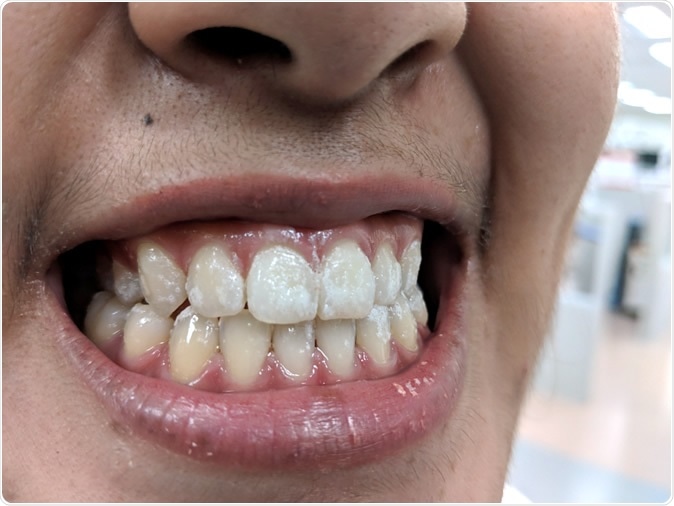Though hugely popular for preventing dental decay in children, fluoride varnish may not be anything but an expensive placebo, it turns out, from the results of a new study by University of Washington researchers.
Many dental care specialists as well as pediatricians have taken to fluoride varnish, which can be used to coat the teeth like a veneer of paint. Once applied with a brush, it dries over a few hours, protecting the teeth against caries. And the child won’t swallow it once it is dry. Almost any minimally trained person can do it.
The cost is also in its favor, at about $25 to $55 a pop, much cheaper than a full-scale dental appointment. However, the question raised by this new study is whether the treatment is worth even this investment.
The study is published in the journal Caries Research.

Teeth with fluoride varnish. Credit: Punrit Thongma-en/ Shutterstock
What did they look for?
The study is a review of 20 clinical trials covering the use of fluoride varnish in 13 countries, either as part of a dental program or as a standalone. They compared the efficacy of fluoride varnish with that of placebo, or of standard care.
The population considered in this review comprised over 13,600 preschool children aged up to 6 years. The review areas included the use of fluoride varnish alone or accompanying a dental health program. The controls included placebo, no care, or usual care. The outcomes looked for were tooth decay (the occurrence of cavities, the number of teeth and tooth surfaces affected, and short-term as well as long-term adverse effects. Decay was evaluated by the number of decayed, missing and filled teeth and surfaces.
The reviewers observed that the study population comprised mostly children who had one or more risk factors for dental decay, who were treated with multiple fluoride treatment, including fluoridated drinking water, fluoride-containing toothpaste, and fluoride varnish. More contemporary trials have targeted both high- and low-risk children.
What did they find?
The reviewers noted that the trials did not prove that fluoride varnish had any protective effect. This was despite the 12% reduction in the risk of new tooth cavities in this population, compared to those children who did not get this treatment. The lack of significance is due to the large prediction interval of 0.68 to 1.14. This means that future studies might predict a risk reduction by 32% or an increased risk by 14% respectively with the use of fluoride varnish. They also predicted that the varnish would have to be applied to 17 children for one child to benefit (with a predicted 50% rate of cavities in children). In their words, “This was a rather modest benefit, as a large number of the children developed new dentine caries lesions, regardless of fluoride varnish use.”
Reasons for the apparent lack of significant effectiveness could include variations in fluoride concentrations among the different varieties used.
What are the alternatives?
More effective alternatives include sealants, that are a little harder to apply properly, but are worth it since they remain active for the next 2-3 years. This is especially relevant for the molars at the back of the mouth which are hard to reach. The best sealants are those with glass ionomers since they release fluoride at a constant rate. Resin-based sealants also work, but don’t supply fluoride.
Another form of fluoride is silver diamine fluoride which is gaining in popularity due to its high effectiveness. However, it may stain the teeth, which affects younger children less as they are due to lose their milk teeth anyway. Another more serious obstacle is the lack of data on the actual preventive efficacy of this fluoride.
Overall, the reviewers support fluoridated toothpaste, due to the low cost, ease of use, and daily application. Fluoride rinses are also almost equally effective in exposing the teeth to fluoride every day. Fluoride varnish doesn’t appear to save costs in preserving the milk teeth, but may do so if used to preserve permanent teeth in a high-risk setting or if used by persons other than professional dental care providers.
Conclusion
The study concludes that more studies will be needed to decide upon whether fluoride varnish is worth its cost in a variety of settings and applications. At present, fluoride varnish is just one of the alternatives to be presented for pediatric dental prevention. And the best thing, even then, would be to stop children from eating too much sweets and sugary drinks, because many children continued to show new tooth decay whether they used fluoride varnish or not.
Journal reference:
de Sousa F, S, O, dos Santos A, P, P, Nadanovsky P, Hujoel P, Cunha-Cruz J, de Oliveira B, H: Fluoride Varnish and Dental Caries in Preschoolers: A Systematic Review and Meta-Analysis. Caries Res 2019;53:502-513. doi: 10.1159/000499639, https://www.karger.com/Article/FullText/499639#